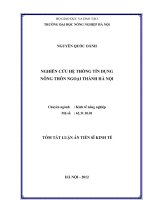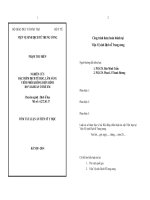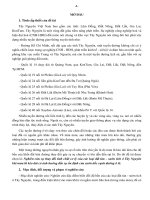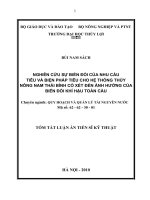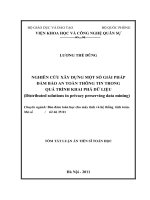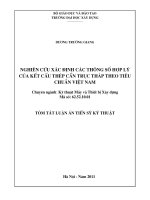Tóm tắt luận án Nghiên cứu lai ghép phân cụm CMeans khả năng mờ và tính toán hạt
Bạn đang xem bản rút gọn của tài liệu. Xem và tải ngay bản đầy đủ của tài liệu tại đây (250.87 KB, 23 trang )
1
Introduction
1. Motivation.
Noise elimination plays a significant role in solving problems of
clustering. Fuzzy possibilistic clustering may be applied to outlier
detection or noise removal. However, one of the disadvantages of
this method is sensitivity to datasets that are large or highdimensional or both. Recently, many researchers are interested in this
issue, but there are no effective methods.
2. Study Objectives
The study objectives of the thesis include: A solution for the fuzzy
possibilistic clustering to deal with the high dimensional and noisy
datasets; A solution for the fuzzy possibilistic clustering to reduce the
noise factor and the uncertainty of the massive data, increase the
quality, and decrease the clustering time; And a solution for the fuzzy
possibilistic clustering to improve the clustering efficiency and deal
with the local optimization situation.
3. Research subjects
The research subjects consist of following problems: Several
algorithms for fuzzy clustering and fuzzy possibilistic clustering;
several methods of granular computing (GrC), granular gravitational
forces (GGF), particle swarm optimization (PSO), and their
application to clustering; the extensions of fuzzy possibilistic
clustering algorithms by GrC, GGF, and PSO.
4. Research scope
Firstly, this research focuses mainly on fuzzy clustering methods,
particularly the fuzzy possibilistic C-means (FPCM) and interval
type-2 FPCM (IT2FPCM) methods, and then investigates methods
of GrC, GGF, and PSO, to improve these clustering methods.
2
Secondly, the combination of the clustering methods with other
methods (GrC, GGF, and PSO); the primary goal of this is to improve
the quality of clustering results.
Finally, experimental results are obtained to demonstrate the
performance of the proposed algorithms.
5. Contributions
This thesis proposes four main algorithms: 1) Propose the
GrFPCM algorithm to cope with the uncertainty factors, address
noises, and alleviate the negative impact of the high dimensionality.
2) Propose the GIT2FPCM algorithm to reduce the noise factor and
uncertainty of the data and decrease the execution time. 3) Propose
the method of combining the GIT2FPCM with the PSO
(PGIT2FPCM) to optimize the objective function. 4) Propose the
AGrIT2FPCM algorithm to improve the distance measurement
between a granule and a centroid of the cluster.
6. Thesis Outline
This thesis is organized into four chapters, as follows: Chapter 1
discusses the major issues and theoretical background. Chapter 2
presents in detail the FPCM algorithm based on GrC. Chapter 3
presents in detail the IT2FPCM clustering based on GGF, or both
GGF and PSO. Chapter 4 states the conclusions which present the
contributions and some recommendation for future research.
Chapter 1. Overview
1.1. Related works
1.1.1. Fuzzy clustering
1.1.2. Fuzzy Possibilistic C-means clustering
The
possibilistic
C-means
(PCM)
method
determines
a
3
possibilistic membership which is used to quantify a degree of
typicality of a point belonging to a specific cluster. FPCM uses the
membership values as well as the typicality values of the PCM to
produce a better clustering algorithm.
1.1.3. Type-2 Fuzzy Possibilistic C-means clustering
The FPCM algorithm is similar to most other type-1 fuzzy
clustering algorithms, which do not address well the uncertainty of
input data. Thus, this algorithm has been improved using type-2
fuzzy sets to develop the type-2 fuzzy possibilistic C-means algorithm.
1.1.4. Granular Computing
GrC has emerged as a powerful vehicle to construct and process
information granules, which are formed by grouping objects based
on their similarity, closeness, or proximity. It is used to handle
complex problems, cope with massive amounts of data, capture
uncertainty, and represent data with high dimensionality. GrC can
solve problems in computational intelligence, and it is a basis for
feature selection methods.
1.1.5. Particle Swarm Optimization
PSO is a resident-based optimization tool that can be used and
applied easily to solve the problem of optimizing transformational
functions. Therefore, PSO algorithms are widely used and are
constantly being improved to further enhance the efficiency of the
algorithm. More recently, researchers approached have used PSO to
improve fuzzy clustering algorithms.
1.2. The limitations of related works and study objectives
The fuzzy possibilistic clustering may be applied to outlier
detection or noise removal. However, one of the disadvantages of
4
this method is sensitive to large or high dimensional datasets or both.
Meanwhile, GrC is a powerful tool to study granulation for handling
complex problems, uncertain information, big data, and high
dimensional data. So GrC may be applied to create preprocessing
steps for clustering. However, it has not been specifically applied to
fuzzy possibilistic clustering algorithms. From these brief analyzes,
the study objectives of the thesis include: 1) Improving the FPCM
clustering based on GrC. It is also considered as an appropriate
solution to clustering problem that deals with the high dimensional
and noisy datasets. 2) Improving the IT2FPCM clustering based on
the GGF. This solution reduces the noise factor and the uncertainty
of the data, increases the quality of clustering, and decreases the
clustering time. 3) Integrating PSO with the GIT2FPCM method to
improve the clustering efficiency. Therefore, this direction is an
appropriate solution for the clustering problem that deals with large
and noisy datasets.
1.3. Theoretical Background
1.3.1. Similarity Measurement
The most commonly used similarity measures for continuous
data: Euclidean distance, Manhattan distance, Minkowski distance,
Mahalanobis distance. This thesis uses Euclidean measurement.
1.3.2. Cluster Evaluation
The evaluation indicators are usually classified into three types:
the internal examination, external assessment, and a relative test.
Both internal and external criteria are used in this thesis.
1.3.3. Fuzzy Clustering
1.3.3.1. Fuzzy C-Means Clustering
1.3.3.2. Possibilistic C-Means Clustering
5
1.3.3.3. Fuzzy Possibilistic C-Means Clustering (Pal et al.)
The objective function of this algorithm is defined as follows:
(1.9)
where ; and .
(1.10)
(1.11)
where .
(1.12)
Algorithm 1.3 FPCM algorithm ( Pal et al.)
1 Input: ,
2 Output: , , and .
3 Initialize , calculate and by using Eq.1.10, Eq.1.11.
4 repeat: Update , , and by using Eq.1.12, Eq.1.10, and Eq.1.11
until: ,
5
Assign data to the cluster if
1.3.3.4. Fuzzy Possibilistic C-Means Clustering (Zhang et al.)
The objective function of FPCM is formed as follows:
(1.13)
where
(1.14)
(1.15)
(1.16)
(1.17)
(1.18)
Algorithm 1.4 FPCM algorithm (Zhang et al.)
1
Input: , , and error .
2
Output: , , and .
3
Execute FCM to find an initial and .
Compute as follows:
4
repeat: Update , , and by using Eq.1.16, Eq.1.17, and Eq.1.18.
Apply Eq.1.15 to compute .
until:
5 Assign data to the cluster if and .
6
1.3.3.5. Interval Type-2 Fuzzy Possibilistic C-Means Clustering
The IT2FPCM is an extension of FPCM (Pal et al.): and; is in
the range ; is in the range ; is in the interval , where:
(1.19)
(1.20)
(1.21)
(1.22)
(1.23)
(1.24)
where
Algorithm 1.5 The interval type-2 fuzzy possibilistic C-Means clustering
1 Input: , , and ε.
2 Outputs: Cluster centroid matrix
3 Initialize the cluster centroids by random.
4 Repeat: Update , by using Eq.1.19-1.22.
Update , by using Eq.1.23, and Eq.1.24;
Reduce the type: Define by using Eq.1.9.
Until .
1.4. Summary
This chapter presented an overview of the fuzzy clustering
methods and related research results, including fuzzy clustering,
fuzzy possibilistic clustering, and interval type-2 fuzzy possibilistic
clustering. Moreover, the techniques used to develop the hybrid
fuzzy clustering methods have been introduced, including GrC, GGF,
and PSO. The final section summarised the theoretical background of
this thesis.
Chapter 2. Fuzzy Possibilistic C-Means Clustering Based on
Granular Computing
This chapter presents the main contents, including the GrC theory,
the feature reduction method based on GrC, the granular space
construction and feature selection method, and the FPCM algorithm
7
based on GrC. The results in this chapter have been published in [II]
and [III].
2.1. Granular Computing
Def.2.1 determines an indiscernibility relation among objects
of X of a clustering system on a subset of features.
Definition 2.1. A clustering system , ,where
is called the value domain of feature . is the information function of the
system, A subset of features, determines an indiscernibility relation .
Based on , is divided in to equivalence classes as .
Suppose that . , such that , which is a set of feature values
corresponding to B. The intention of an information granule , and the
extension
A granule for a clustering system is defined as Def.2.2.
Definition 2.2. Let be a clustering system. An information granule is defined
as where refers to the intention of the information granule and
represents the extension of the information granule.
The system granularity of B, denoted , defines the granularity of the
clustering system on a subset of features.
(2.1)
2.2. Feature reduction based on granular computing
Def.2.4, Def.2.5, and Def.2.6 determine a reduction set of features:
Definition 2.4. The significance degree of feature is defined as follows:
(2.2)
A larger value of takes, the indicates that “” is more important.
Definition 2.5. Given , the feature is called a redundant feature to A if the
value of is equal to . The set of all necessary features is called the core of ,
denoted .
Definition 2.6. Given a clustering system and a set of features set is
called a reduction. The set of all reductions of A is denoted by .
Algorithm 2.1 Feature reduction based on GrC
1
Input: .
2
Output: Set of features that is the minimum reduction of.
8
3
4
Step 1: Determine the core of features as follows:
For each if then select into .
Step 2: Assign
If then the termination criterion is satisfied.
repeat: For each , calculate .
Find the so that
Add feature to the core:
until: .
2.3. Granular space construction and feature selection
In this research, we propose a method of granule formation. The
objects are clustered into clusters by the FPCM on each feature. The
clusters are labelled by numbering them in ascending order (1, 2..).
Therefore, a cluster label matrix is formed from the label of the object
on the feature . The new information function
is denoted as = . From the values of a row in the , with , we can
construct a granule , in which .
Definition 2.7. A non-conflict granular space is formed by , in which , , and .
Conversely, a conflict granular space is formed by .
The significance of a feature only affects the .
Algorithm 2.2 Granular space construction and feature selection
1
Input: , , , and .
2
Output: The minimum reduction of and
3
Step 1: Execute Algorithm 1.4 on each to form .
4
Step 2: Construct granular space
4.1 Initialize: ( is the index of the row of the , is the index set, and is
the number of granules).
4.2 Remove the outlier objects: and if . Then, remove if .
4.3 repeat
4.3.1 ; repeat until
4.3.2 Set to the set of values of the row
4.3.3 Find
if then
4.3.4.1 for each :
4.3.4.2
4.3.4.3 if then
9
5
else
until
Step 3: Apply Algorithm 2.1 on GrSN to reach the minimum reduction C.
2.4. Fuzzy possibilistic C-means clustering based on GrC
We consider with . The value interval of the feature of is :
(2.5)
(2.6)
where is the value of object on the feature.
The distance between and the centroid :
(2.7)
where
(2.8)
(2.9)
(2.10)
(2.11)
where = and = with .
Algorithm 2.3 Fuzzy possibilistic C-meansclustering based on GrC
1
Input: , , , and noise filter parameter .
2
Output: , , and .
3
Step 1: Apply Algorithm 2.2 on to obtain , .
4
Step 2: Apply Algorithm 1.4 on , as follows:
4.1
The number of iterations: .
4.2
repeat: .
Update by using Eq. 2.9.
Remove the outlier or noisy granules:
.
Update by using Eq. 2.10.
Update by using Eq. 2.11.
Apply Eq. 1.15 to compute .
until: ,
5 Assign to the cluster if and .
2.5. Time complexity
The complexity of the GrFPCM depends on the FPCM
and the granular space construction and feature selection:
Form : construct a granular space: , apply Algorithm 2.1:
. In addition, FPCM is applied on : . So the time complexity
10
of GrFPCM is .
2.6. Experimental studies
2.6.1. Experiment 1
The well-known datasets WDBC, E. coli promoter gene sequences
(DNA), and Madelon1 were used. The clustering results were evaluated
by determining TPR and FPR, in Table 2.6.
Table 2.6: Clustering results for experiment 1.
Dataset
FCM
FS TPR FPR
FS
WDBC
30
30
DNA
57
Madelo
n
50
0
89.5
%
85.6
%
86.1
%
4.5
%
6.7
%
5.9
%
57
50
0
FPCM
TPR
FPR
92.7
%
91.4
%
90.8
%
2.8
%
3.1
%
3.3
%
F
S
4
2
12
GrFPCM
TPR
FPR
95.4
%
96.1
%
94.8
%
1.9
%
1.7
%
2.1
%
2.6.2. Experiment 2
Five public datasets (Lymphoma, Leukaemia, Global Cancer Map
(GCM), Embryonal Tumours (ET), and Colon2) were used to illustrate
the application of the proposed method to high-dimensional datasets.
Table 2.8: Clustering results for experiment 2.
FCM
FCM(FS)
FPCM
FPCM(FS)
GrFPCM
TPR FPR TPR FPR TPR
FPR TPR FPR TPR
FPR
Lymphoma 89.2% 4.6% 89.9% 4.2% 89.8% 3.1% 93.2% 1.8%
96.1 1.7%
%
Leukaemia 72.1% 9.5% 82.1% 7.2% 81.4% 7.3% 89.4% 4.2%
93.6 1.4%
%
GCM
89.6% 4.8% 90.4% 3.2% 90.2% 5.5% 93.2% 2.5%
96.8 1.2%
%
ET
80.1% 9.1% 87.6% 6.3% 88.1% 7.6% 91.1% 4.6%
95.3 1.9%
%
Colon
79.1% 7.9% 81.7% 6.9% 80.9% 9.5% 86.8% 4.9%
92.8 3.4%
%
Dataset
Table
2.8 shows that
the TPR values obtained by executing GrFPCM
/>mlearn/mlrepository.html
/>on the five datasets are greater than 92% and obviously higher than
those obtained by the other methods. In addition, the FPR values are
smaller than those achieved by the other algorithms. For FCM and
1
2
11
FPCM, the TPR and FPR values obtained after reducing features are
better than those obtained without reducing features.
2.7. Granular fuzzy possibilistic C-means clustering approach to
DNA microarray problem
2.7.1. Cluster analysis for gene expression data
A gene expression dataset from a microarray experiment can be
represented by a real-valued expression matrix , where rows represent
genes, columns represent different samples, and the numbers in each
cell represent the expression level of gene in sample . We
consider the samples to be objects, and the genes to be features.
2.7.2. Results
Table 2.11: Clustering results with IC index values of the experimental datasets
No
1
2
3
4
5
6
7
8
9
10
11
12
13
14
15
16
17
18
19
20
Datasets
Leukaemia-V1
Leukaemia-V2
Leukaemia-2c
Leukaemia-3c
Leukaemia-4c
Lung Cancers-V1
Lung Cancers-V2
Human Liver Cancers
Breast, Colon Cancers
Breast Cancers
Colon Cancers
Prostate Cancers -V1
Prostate Cancers -V2
Bone marrow-V1
Bone marrow-v2
Ovarian
Lymphoma
CNS
SRBCT
Bladder Cancers
Incorrectly clustered instances (%)
K-means
FCM
FPCM
GrFPCM
N.I
%
N.I
%
N.I
%
N.I
%
22 30.5556 20 27.7777 18
25
2
2.7778
21 29.1667 21 29.1667 15 20.8333
0
0
21 29.1667 20 27.7777 17 23.6111
2
2.7778
34 47.2222 18
25 13 18.0555
1
1.3889
42 58.3333 22 30.5556 22 30.5556 15 20.8333
96 47.2906 95
46.798 61 30.0493 35 17.2413
30 16.5746
2
1.105
2
1.105
0
0
80 44.6927 89 49.7207 80 44.6927 22 12.2905
44 42.3077 15
14.431
8 7.6923
3
2.8846
45 46.3918 37 38.1443 29 29.8969 18 18.5567
14 37.8378 13 35.1351 13 35.1351 11 29.7297
51 46.3636 63 57.2727 56 50.909 31 28.1818
55 52.8846 40 38.4615 65
62.5 29 27.8846
88 35.4839 87 35.0806 50 20.1613
6
2.4194
169 68.1452 107 43.1452 170 68.5484 73 29.4354
112 44.2688 86
33.992 75 29.6442
2
0.7905
22 33.3333 20
30.303 20 30.303 10 15.1515
29 48.3333 26 43.3333 19 31.6666 15
25
52 62.6506 27 32.5301 22 26.506
5
6.0241
18
45 18
45
8
20
5
12.5
We performed clustering on the 20 gene expression datasets in
Table 2.11 by executing K-means, FCM, FPCM, and GrFPCM.
The clustering results show that the GrFPCM is superior over all 20
datasets; in particular, the IC index values equa l0 with two datasets.
Additional, the datasets with different feature selection algorithms
were compared to the datasets in which features were selected by the
12
proposed algorithm. The ARI values of K-means, FMG, SNN, SL, CL,
AL, and SPC methods were taken from reference, and ARI values
were calculated for 12 datasets with FCM, FPCM, and GrFPCM.
Table 2.14: Clustering results with ARI values of the CL, FMG, SPC,
K-means (KM), FCM, FPCM, and GrFPCM methods datasets.
No
1
2
3
4
5
6
7
8
9
10
11
12
Datasets
Leukaemia-V1
Leukaemia-V2
Lung Cancers-V1
Lung Cancers-V2
Human Liver Cancers
Breast, Colon Cancers
Colon Cancers
Prostate Cancers -V1
Prostate Cancers -V2
Bone marrow-V1
Bone marrow-v2
Bladder Cancers
Mean
Standard deviation
FS
1081
2194
1543
1626
85
182
2202
1288
2315
2526
2526
1203
CL FMG SPC KM FCM FPCM GrFPCM
ARI ARI ARI ARI ARI ARI GrFS ARI
0.18 0.27 0.78 0.27 0.32 0.38
34 0.89
0.49 0.88 0.88 0.37 0.37 0.54 150
1
0.33 0.26 0.27 0.42 0.25 0.34 512 0.45
0.92 -0.05 0.05 0.85 0.95 0.95
93
1
-0.01 0.73 0.04 0.42
0.4 0.42
80 0.59
0.92 0.07 0.92 0.42 0.53 0.71
22 0.89
-0.02 0.46 0.02 0.24 0.17 0.25
11 0.37
0.23 0.26 0.18
0.4 0.32 0.38
60 0.52
0.32 0.36 0.07 0.48 0.51 0.31 216 0.62
-0.08 0.96 0.21 0.52 0.53 0.61 216 0.88
0.27 0.36 0.23 0.37 0.41 0.36 186 0.63
0.11 0.65 0.40 0.15 0.36 0.45
79 0.63
0.30 0.43 0.34 0.41 0.43 0.48
0.71
0.33 0.31 0.34 0.17 0.20 0.20
0.22
Fig. 2.5: ARI values with feature selection for FMG, CL, K-means,
SPC, and GrFPCM.
2.8. Summary
This chapter presented an advanced FPCM method based on GrC
(GrFPCM), which can reduce the feature space to produce a set of
essential features, and eliminate irrelevant features and noise
objects. GrFPCM takes advantage of the fuzzy possibilistic
memberships to deal with vague values. In addition, GrFPCM
13
handles uncertainty factors efficiently and alleviates the negative
impacts of the high dimensionality of problems. The experiments
demonstrated that GrFPCM obtains better clustering results than
other methods; in particular, this algorithm potentially enhances the
clustering results when working with gene expression data.
Chapter 3. Interval Type-2 Fuzzy Possibilistic C-Means
Clustering Based on Granular Gravitational Forces and PSO
Chapter 2 presented some results of an improved FPCM algorithm
based on feature noise reduction using GrC. This chapter presents
some results, in the direction of reducing noise and uncertainty of
data objects, by extending the IT2FPCM algorithm using GGF and
PSO. The results in this chapter have been published in [I] and [IV].
3.1. Interval type-2 fuzzy possibilistic C-means clustering based
on granular gravitational forces
3.1.1. Granular gravitational model
The law of universal gravitation states that two points interact
with each other by a gravity force. This is the main idea of clustering
algorithms based on granular gravity.
3.1.2. Gravitational granular space construction
We present a method of advanced gravitational granular space
construction, in which the granule grouping steps are improved. The
IT2FPCM method is performed on the resulting granule set.
The information granule is represented by (position), (mass),
and (gravitational density of the granule)
Algorithm 3.1 Group granules and initialize centroids
1 Input: , , and .
2 Output: , .
3 Step 1: 3.1 Assign number of initial granules .
3.2 Initialize granules: .
4 Step 2: repeat:
14
4.1
4.2
4.3
4.4
Calculate all gravitational forces:
Calculate gravitational density: with .
Sort granules according to :.
Finding , nearest granule from :
4.4.1 Update the mass of : .
4.4.2 Determine gravitational centroid:
.
4.4.3 Determine factor : .
4.4.4 Update position: .
4.4.5 and , .
until: .
5 Step 3: Determine initial centroids:
5.1 Initializing granule set: with , .
5.2 repeat: Group the granule set according to step 2
until: .
5.3 Determine with , .
3.1.3. Interval type-2 fuzzy possibilistic C-means clustering based
on granular gravitational forces
GIT2FPCM performs the IT2FPCM algorithm on the granular
space with input dataset .
(3.9)
(3.10)
where .
(3.11)
(3.12)
(3.13)
(3.14)
where and .
The type reduction is performed as follows:
(3.15)
(3.16)
(3.17)
Algorithm 3.2 IT2FPCM clustering based on GGF.
1 Input: and .
2 Output:
3
Step 1: Apply Algorithm 3.1 to obtain and
4 Step 2:
4.1 Update and using Eq. 3.9 and Eq. 3.10.
15
4.2
4.3
4.4
4.5
Update and using Eq. 3.11 and Eq. 3.12.
Update and according to Eq. 3.13 and Eq. 3.14.
Reduce type of , , and using Eq. 3.15-3.17.
Calculate the objective function as follows:
(3.18)
5 Step 3: Repeat step 2 until .
3.2. Interval type-2 fuzzy possibilistic C-means clustering based
on granular gravitational forces and PSO
3.2.1. Particle swarm optimization
3.2.2. Interval type-2 fuzzy possibilistic C-means clustering based
on granular gravitational forcesand PSO
From the set of initial clustering centroids, obtained from
Algorithm 3.1, we randomly generate sets of initial cluster centroids.
These sets of initial cluster centroids are considered as particles of
the swarm. The best position of the particle corresponds to the set of
cluster centroids for which the objective function value of particle is
the smallest. Similarly, the best position of the swarm corresponds to
the set of cluster centroids for which the objective function value of
the swarm is the smallest.
Algorithm 3.3 IT2FPCM clustering based on GGF and PSO.
1 Input: , , , and ; PSO parameters.
2 Output:
3
Step 1: Apply Algorithm 3.1 to obtain and .
Set up a swarm of N particles: .
4
Step 2:
4.1 Determine the fuzzy partition matrix for each particle.
4.2 Determine the possibilistic partition matrix for each particle.
4.3 Determine for each particle based on the objective function.
4.4 Determine for the swarm based on the objective function.
4.5 Update the velocity matrix of each particle.
4.6 Update the position matrix of each particle.
4.7 If PSO termination criteria are not satisfied, return to step 2.
5 Step 3:
5.1 Apply GIT2FPCM (step 2, step 3) for each particle where the initial
cluster centroid is .
5.2 Update for each particle.
16
5.3 Determine for the swarm.
6 Step 4: If PGIT2FPCM termination criteria are not satisfied, return to step 2.
3.3. Interval type-2 fuzzy possibilistic C-means clustering based
on advanced granular computing
In this method, GrC is used to create granules for dimensionality
reduction, and then the method of GGF is used to determine the
centroids of granules, to improve the measurement of the distance
between the granules and the cluster centroids.
3.3.1. Determine the centroids of granules based on granular
gravitational forces
Firstly, the grouping process is repeated until only one point
remains in each granule. Secondly, the position of the remaining
point is considered to be the corresponding granule centroid.
Algorithm 3.4 Determine the centroids of granules
1
2
3
4
Input: with .
Output: Set of centroids of granules .
For to
Step 1:
4.1 Assign number of initial points .
4.2 Initialize points in granule: and .
5
Step 2:
repeat:
5.1 Calculate all gravitational forces in the granule:
with ,
5.2 Calculate gravitational density for each point: .
5.3 Sort points in the granule according to in descending order.
5.4 Find , the nearest point from , and group points and .
5.4.1
Update mass of : .
5.4.2
Determine gravitational centroid:
.
5.4.3
Determine factor : .
5.4.4
Update position .
5.4.5
Update number of points in granule:
until: .
6
Step 3: Centroid of granule: .
7 Next.
17
3.3.2. Interval type-2 fuzzy possibilistic C-means clustering based
on advanced granular computing
In this section, we improve the granular space,
which is the result of Algorithm 2.2. We then apply the
IT2FPCM algorithm to clustering on the advanced
granular space.
In the advanced granular space (AGS), the distance
between a granule and the centroid of cluster is
determined by Eq. 3.28.
(3.28)
in which is the result of Algorithm 3.4.
Algorithm 3.5 AGrIT2FPCM
1 Input: , , , , error , and noise filter parameter .
2 Output: , , .
3 Step 1: Apply Algorithm 2.2 on to obtain the feature set ,
which is the minimum reduction of and the granular
space .
4 Step 2: Apply Algorithm 3.4 on to obtain
5 Step 3: Apply the IT2FPCM on , as follows:
5.1 The number of iterations is set to
5.2 repeat:
5.2.1
5.2.2 Update .
5.2.3 Remove the outlier or noisy granules
5.2.4 Update .
5.2.5 Update .
until:
6 Assign to the cluster if and .
3.4. Time complexity
The time complexity of calculating the granule grouping and
centroid initialization: ; IT2FPCM: , and PSO: . Therefore, the
time complexity of both GIT2FPCM and PGIT2FPCM are .
In addition, the time complexity of calculating the granular
space construction and feature selection: , determining
18
the centroids of granules: and IT2FPCM: . Thus, the time
complexity of AGrIT2FPCM is
3.5. Experiments
3.5.1. Experiments with the GIT2FPCM and PGIT2FPCM
For a comparative analysis, several clustering methods were used,
including FPCM, IT2FPCM, and GIT2FPCM, PGIT2FPCM which
are the proposed algorithms. Validity indexes were used to evaluate
the clustering results, including PC-I, CE-I, and XB-I. The execution
time of the algorithms was also evaluated. The well-known datasets
were considered as listed in Table 3.1.
Table 3.1: Characteristic of datasets.
Dataset
Iris
Haberman’s Survival
Banknote Authentication
HTRU2
Number of
samples
150
306
1372
17898
Number of
features
4
3
4
8
Number of
classes
3
2
2
2
A larger PC-I index, or a smaller CE-I or XB-I index, indicates a
better clustering result. Thus, from the results in Table 3.2,
GIT2FPCM and PGIT2FPCM obtained better results than FPCM
and IT2FPCM. The PGIT2FPCM algorithm achieved the best PC-I
and CE-I indices on all datasets, and the GIT2FPCM algorithm
achieved the best XB-I index on the majority of the datasets.
The synthesis results in Table 3.2 indicate that the execution time
of the proposed algorithms was less, and hence they are more
efficient than the existing algorithms. The average execution time of
the GIT2FPCM algorithm was less than FPCM or IT2FPCM by a
factor of several hundred; the execution speed of the PGIT2FPCM
algorithm was also several times faster than FPCM or IT2FPCM.
Moreover, the larger the dataset, the more efficient they were. By
reducing the number of elements in the granular space, the proposed
algorithms showed significantly better performance on large datasets.
19
Table 3.2: Validity indices and times from four clustering algorithms
Dataset
Iris (150;4;3)
Haberman’s
Survival
(306;3;2)
Banknote
Authentication
(1372;4;2)
HTRU2
(17898;8;2)
Index
PC-I
CE-I
XB-I
T
PC-I
CE-I
XB-I
T
PC-I
CE-I
XB-I
T
PC-I
CE-I
XB-I
T
FPCM
0.783167
0.395949
0.137148
18.454
0.739771
0.413675
0.222922
33.665
0.737558
0.418323
0.178647
280.833
0.812079
0.311227
0.168908
4746.24
Algorithm
IT2FPCM GIT2FPCM PGIT2FPCM
0.783551
0.785561
0.785563
0.395634
0.393457
0.393455
0.134695
0.127773
0.127775
13.51
0.046
10.936
0.742654
0.746108
0.747386
0.409478
0.404494
0.401771
0.210895
0.193094
0.194350
24.398
0.109
21.591
0.737870
0.750121
0.750159
0.418043
0.400196
0.400193
0.178848
0.146360
0.146339
110.886
0.936
31.247
0.814396
0.872349
0.872517
0.308114
0.222784
0.222720
0.162629
0.070581
0.070638
1971.81
82.962
393.029
Fig. 3.1: Validity indices and execution times obtained by four
clustering algorithms.
3.5.2. Experiments with the AGrIT2FPCM algorithm
In this section, we also offer a comparative analysis of the
clustering results using various clustering methods: FPCM, GrFPCM
20
(FPCM perform on the granular space from Algorithm 2.2), and
AGrIT2FPCM. Of these three, AGrIT2FPCM is the proposed method.
The performance of the clustering algorithms was evaluated by TPR
and FPR, which are defined in Eq. 2.12. While FPCM performs
clustering on the original datasets with all features, GrFPCM perform
clustering on the granular space which are the output of Algorithm 2.2,
and AGrIT2FPCM perform clustering on the advanded granular space.
Table 3.5: Characteristics of datasets and feature selection.
Dataset
Number of Number
samples of features
569
30
WDBC1
DNA
1
Madelon1
Lymphoma
Leukaemia
106
57
2
2
4400
500
2
12
45
4026
2
15
38
7129
2
6
190
16063
14
16
60
7129
2
8
62
2000
2
9
2
Global Cancer Map(GCM)
Embryonal Tumours
Colon
2
Feature
Selection
4
2
2
2
2
Class
Table 3.6: TPR and FPR for FPCM, GrFPCM, and AGrIT2FPCM.
Dataset
FPCM
FS
TPR FPR
WDBC
30 92.6% 2.8%
DNA
57 91.5% 2.80%
Madelon
500 90.8% 3.30%
Lymphoma
4026 88.9% 2.20%
Leukaemia
7129 81.6% 7.90%
Global Cancer
16063 90.0% 5.30%
Map
Embryonal
7129 88.3% 8.30%
Tumours
Colon
2000 80.6% 9.70%
GrFPCM
FS
4
2
12
15
6
TPR
95.4%
96.20%
94.80%
95.60%
94.70%
AGrIT2FPCM
FPR FS
1.9% 4
1.90% 2
2.10% 12
2.20% 15
2.60% 6
TPR
96.1%
97.20%
95.80%
95.60%
97.40%
FPR
1.6%
1.90%
1.90%
2.20%
2.60%
16 96.80% 1.10% 16 97.90% 1.10%
8 95.00% 1.70%
8 96.70% 1.70%
9 93.50% 3.20%
9 95.20% 3.20%
The clustering results (the classification quality) are reported in
1
mlearn/mlrepository.html
2
/>
21
terms of the TPR and FPR indices, and are shown in Table 3.6. A
higher TPR value and lower FPR value indicate a better algorithm.
Table 3.6 shows that the TPR values obtained by AGrIT2FPCM are
greater than 95% and obviously higher than those obtained by other
methods. Additionally, the FPR values are smaller than those
achieved by other algorithms.
3.6. Summary
This chapter presented advanced IT2FPCM clustering based on
GGF and PSO. Granules are constructed from the original data
objects, by grouping based on GGF, to create a dataset of granules.
We then proposed the GIT2FPCM algorithm, which performs
IT2FPCM clustering on the set of granules. This method also reduces
the noise factor and uncertainty of the data, thereby increasing the
quality of the clustering. Further, the clustering time decreases
significantly, as a consequence of the reduced dataset size. Moreover,
we proposed a method of combining the GIT2FPCM algorithm with
the PSO algorithm to optimize the objective function and improve the
quality of clustering. Additionally, the AGrIT2FPCM algorithm was
presented in this chapter. Based on GGF, this algorithm determines
the centroids of granules to improve the measurement of the distance
between the granules and the centroids of the cluster. This algorithm
also utilizes the advantages of IT2FPCM for processing uncertainty
and noisy data.
Chapter 4
4 Conclusions
The main contributions of this thesis are summarized in this section.
1. We proposed GrFPCM, an algorithm for the FPCM based on GrC.
This algorithm constructs the granular space to eliminate the effects
of irrelevant features and noise objects. FPCM is then executed on
22
the granular space. Therefore, the GrFPCM copes with the uncertainty
factors and alleviate the negative impact of the high dimensionality
of problems. The DNA microarray problem was presented, as an
application of the GrFPCM. The results demonstrated that GrFPCM
achieves better results than some other existing clustering methods.
2. We proposed GIT2FPCM, an algorithm for the IT2FPCM
clustering based on GGF. This algorithm is to construct granules
from the original data objects by grouping based on GGF. The
IT2FPCM clustering method is executed on the set of granules and
the initial cluster centroids. This method reduces the noise factor and
uncertainty of the data, thereby increasing the quality of the clustering.
Furthermore, the clustering execution time decreases significantly, as
a consequence of the reduced dataset size.
3. We proposed a method of combining GIT2FPCM with the PSO, to
optimize the objective function and enhance clustering efficiency. This
method considers sets of initial cluster centroids, obtained from
GIT2FPCM, as the particles of the swarm. A combination of updating
the positions of the centroids and updating the positions of the
particles is performed, to determine the best positions of the centroids.
4. We proposed AGrIT2FPCM, an algorithm for the IT2FPCM
clustering based on advanced GrC. Based on GGF, this algorithm
determines the centroids of the granules that are created by the
GrFPCM, by improving the measurement of distance between the
granules and centroids of the clusters. Further, this algorithm utilizes
the advantages of IT2FPCM in processing uncertainty and noisy
datasets.
23
Publications
[I].
Trương Quốc Hùng, Ngô Thành Long, Phạm Thế Long; Phân
cụm C-Means khả năng mờ loại hai khoảng dựa trên hạt giảm
chiều cải tiến; Tạp chí Nghiên cứu Khoa học và Công nghệ
Quân sự; Số 59; 2019.
[II]. Hung Quoc Truong, Long Thanh Ngo, Witold Pedrycz;
Advanced Fuzzy Possibilistic C-Means Clustering Based on
Granular Computing; IEEE International Conference on
Systems, Man, and Cybernetics (SMC); 2016 (DOI:
10.1109/SMC.2016.7844627).
[III]. Hung Quoc Truong, Long Thanh Ngo, Witold Pedrycz; Granular
Fuzzy Possibilistic C-Means Clustering Approach to DNA
Microarray Problem; Knowledge-Based Systems; 133; pp.5365;
2017
(SCI
-
Q1
ranking
DOI:10.1016/j.knosys.2017.06.019 - IF: 4.396).
[IV]. Hung Quoc Truong, Long Thanh Ngo, Long The Pham;
Interval Type-2 Fuzzy Possibilistic C-Means Clustering Based
on Granular Gravitational Forces and Particle Swarm
Optimization; Journal of Advanced Computational Intelligence
and Intelligent Informatics; 23(3); pp.592-601; 2019 (Scopus Q3 ranking).
